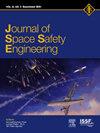ASTROBEAT: Advancing cold-welding technology for in-situ spacecraft repairs
IF 1.7
Q3 ENGINEERING, AEROSPACE
引用次数: 0
Abstract
This paper presents an overview of ASTROBEAT, an innovative in-orbit mission to investigate cold-welding as a new method for repairing spacecraft hull damage caused by hypervelocity impacts. The experiment is a technology demonstrator, launched on November 5, 2024, aboard a SpaceX CRS mission, to test cold-welding under microgravity conditions on the International Space Station (ISS). The phenomenon, which involves the fusion of similar metals at ambient temperatures under high contact pressures, benefits from the space environment, where the absence of reoxidation facilitates atomic diffusion, enabling bonding at reduced forces. The ASTROBEAT experimental setup, housed within a 1 U cube Nanolab installed on an ISS rack, incorporates material test beds, a hull perforation repair device, and custom electronic and data acquisition systems. The core experiment involves preloaded springs delivering controlled forces to metal pairs (CuSn4 and Al-2024T) designed to simulate patch applications for spacecraft hull breaches. A pico-camera monitors the actuation process to ensure successful deployment, while electrical resistance measurements provide real-time data on the welding process. Functional testing and in-orbit operations showed that ASTROBEAT worked nominally. Post-flight, the payload will be recovered for further analysis. By demonstrating the feasibility of cold-welding for spacecraft repair, ASTROBEAT addresses a critical gap in standardized in-situ maintenance solutions, enhancing spacecraft safety and enabling long-term sustainability in space exploration.
ASTROBEAT:推进航天器原位修复的冷焊技术
ASTROBEAT是一项创新的在轨任务,旨在研究冷焊作为修复超高速撞击造成的航天器外壳损伤的新方法。该实验是一项技术演示,于2024年11月5日发射,搭载SpaceX CRS任务,在国际空间站(ISS)微重力条件下测试冷焊。这种现象涉及在高接触压力下类似金属在环境温度下的融合,得益于空间环境,在空间环境中,没有再氧化有利于原子扩散,使键合力降低。ASTROBEAT实验装置位于安装在国际空间站机架上的1u立方体纳米实验室内,包括材料试验台、船体穿孔修复装置以及定制的电子和数据采集系统。核心实验涉及预加载弹簧,向金属对(CuSn4和Al-2024T)提供受控力,设计用于模拟航天器外壳裂口的修补应用。微型摄像机监控驱动过程以确保成功部署,而电阻测量提供焊接过程的实时数据。功能测试和在轨运行表明ASTROBEAT运行正常。飞行后,有效载荷将被回收以进行进一步分析。通过展示冷焊修复航天器的可行性,ASTROBEAT解决了标准化原位维护解决方案的关键空白,提高了航天器的安全性,并实现了太空探索的长期可持续性。
本文章由计算机程序翻译,如有差异,请以英文原文为准。
求助全文
约1分钟内获得全文
求助全文
来源期刊

Journal of Space Safety Engineering
Engineering-Safety, Risk, Reliability and Quality
CiteScore
2.50
自引率
0.00%
发文量
80
 求助内容:
求助内容: 应助结果提醒方式:
应助结果提醒方式:


